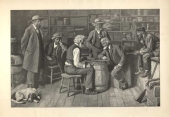The Checker Maven
The World's Most Widely Read Checkers and Draughts Publication
Bob Newell, Editor-in-Chief
Published every Saturday morning in Honolulu, Hawai`i
Noticing missing images? An explanation is here.
How Fast Can You See?

Our infamous clock will start the instant you click on the links below, and we're timing you right down to the millisecond. Test your visualization: how fast can you see?
Solutions can be verified by clicking Read More, though we're pretty sure you won't need much help.
![]()
The Dodger
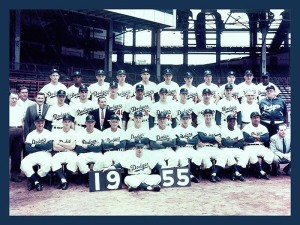
At the time that this article achieves publication, it will be near the end of the 2005 baseball season. But, since quite a few of our pieces are written well in advance, we don't know at the moment who the pennant contenders might be.
The Dodgers, of course, were in the running for many a year. We're referring, naturally, to the immortal Brooklyn Dodgers, the "Brooklyn Bums" beloved of many a checker player, including Willie Ryan and, we're certain, Tommie Wiswell.
In fact, today's feature problem is called "The Dodger" though it doesn't have any sort of baseball theme that we can readily discern. Here's the situation:
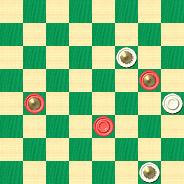
WHITE
White to Play and Win
"Dodge" erroneous play, win the pennant for White, and check your answer by clicking on Read More.![]()
A Wiswell Doubleheader


Today we bring you two Tom Wiswell problems--- a doubleheader--- which bear a certain relationship. If you solve the first one, it will help you with at least one major variant of the second one.
But this doesn't mean that a "Sunday doubleheader" (alas, seldom seen these days) will turn into a "Sunday picnic." Not at all. In fact, when these problems appeared around sixty years back, there was plenty of discussion and controversy. In the end, Mr. Wiswell collaborated with one of the more colorful checker characters ever (next to Willie Ryan): Mr. Julius D'Orio, he of the "triangle" theory of checkers, to come up with a definitive solution.
And, as we shall see, modern computer analysis bears out the solution to what has been called the D'Orio-Wiswell Position.
BLACK
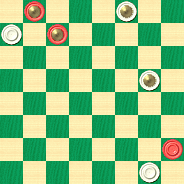
WHITE
White to Play and Win
Did you get that one? Now try this one:
BLACK
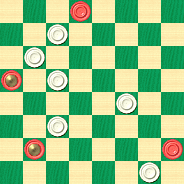
WHITE
White to Play and Win
White is two men up, so it's easy--- until you try it.
When you've played out both ends of the doubleheader, click on Read More for solutions and commentary.![]()
September 23 is Checkers Day!

If you're a checker player and you've somehow never heard of this, there's a reason. The origin of Checkers Day lies not in the game of checkers, but in the fact that on September 23, 1952, Richard M. Nixon, then a candidate for Vice-President of the United States, gave his famous "Checkers" speech. "Checkers" was the name of the Nixon family dog; perhaps that is why September 23 is also "Dogs in Politics" day.
But let's set the politics aside, and celebrate Checkers Day in our own way ... with a few games of checkers, perhaps a little coffee and cake, and plenty of fun!![]()

Fore!
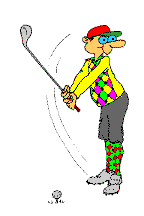
Oh ... we didn't really mean that kind of stroke, but actually this kind:
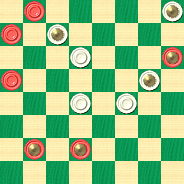
WHITE
White to Move and Win
Can you bring the solution to the "fore" with this month's somewhat easier stroke problem? Click on Read More to see if your solution is up to "par"!![]()
Simple Elegance

Complex stroke problems are fun, and crowded middle game positions can be a challenge, but there is little to compare with the sheer, simple elegance of a well-composed 2x2 end game problem. Here is a real classic, attributed to G. H. Slocum.
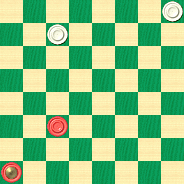
BLACK
Black to Play and Win
When you've solved this, we think you'll agree that there is genuine charm in such a compact position, requiring just the right play. Click on Read More to see the main line solution as originally published long ago.![]()
Today is Bob Murr Day!
Today we're recognizing another major contributor to the work of The Checker Maven. Bob Murr, expert checkerist from Colorado Springs, has helped us in many ways on many occasions, with feedback, corrections, new material, and on-site reporting.

To accompany today's Checker Maven articles, Bob has provided us with PDN files for both Ryan's Tricks, Traps & Shots of the Checkerboard as well as Ginsberg's Principles of Strategy in the Game of Checkers. You can find these in the new PDN section of our Downloads category, as listed in the column to the right.
Our thanks to Mr. Murr for his continued support of The Checker Maven and the great game of checkers!![]()
A Leak in the Dyke

In 1931, the great checkerist Louis C. Ginsberg wrote what may be his only book on checkers, a little booklet called Principles of Strategy in the Game of Checkers. It was later reprinted by William Ryan, with the addition of an informative and highly entertaining introduction.
Principles of Strategy appears to have been the prototype for other similar booklets which never got written, although we can't be quite sure about this. Principles of Strategy, while mentioning the existence of numerous other characteristic formations in the game of checkers, deals exclusively with what are known as "Dyke" formations.
The booklet is a real gem and a welcome addition to the library of any checkerist; it is especially useful at the early intermediate stage of development. In conjunction with Bob Murr's PDN file of the examples contained in this work (see link in the column to the right), today we'll present the full text of two of these examples. Pay close attention to the Example 15 below, as it will help you solve the problem we pose later.
"DYKE" FORMATIONS---EXAMPLE 15
9-13 24-20
11-15 22-17
13-22 25-11
8-15 21-17
4-8 29-25
15-19-A 23-16
12-19 27-23
8-12 23-16
12-19 17-13-B
10-15-C 20-16
6-1-D Drawn
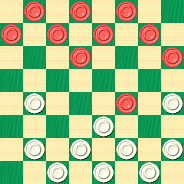
WHITE
Position at Note A, White to Move
A---This illustration is given to show when Black can place a piece on 19 with apparently only two pieces in reserve for the defense of the man. There must be a White man on 17.
B---White must remove the man from 17 before going 32-27 to attack the man on 19.
C---Black gains a move, an idea that is utilized in many different games, due to the White man being located on 17. If there was no White man on 17, the man on 19 would be lost to Black by the runoff via 27-23.
Get the idea? Now let's look at a Dyke example that arises in the Single Corner opening:
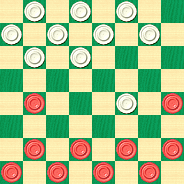
BLACK
Dyke Position with Black to Play
11-15 22-18
15-22 25-18
12-16 29-25
9-13 18-14
10-17 21-14 (diagram above)
16-20 24-19
6-10 25-21
10-17 21-14
2-6 30-25
6-10 25-21
10-17 21-14
1-6 Black Wins.
The White "Dyke" man on 14 is lost as there is no defense against Black's next move, 6-10.
What went wrong here? We've left it to you to find the leak in this Dyke. Can you find White's losing move and correct it? Click on Read More when you have your answer.![]()
Two Not-Quite-So-Easy Pieces
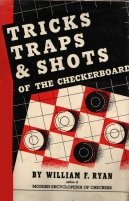
We've been slowly but surely republishing Willie Ryan's Tricks Traps & Shots of the Checkerboard in a brand new electronic edition, and we've been referring to the introductory problems in the book as "Easy Pieces."
Well, some readers have pointed out that not all of these problems have been exactly easy, and that they've been getting harder as they go. So, this month, we're abandoning any pretense of ease of solution, and again letting Willie speak for himself. Try the problems and check your answers by clicking on Read More. As usual, the Black side is shown in regulation Red.
They may not be easy, but they certainly are good!
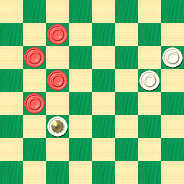
BLACK
Black to Play and Win
"A little logic should make the issue clear in Example 13. Black is a piece ahead, but the white king on square 11 is pressing (chasing) an attack from the rear. The natural course for black is to avoid capture by going 16-20, white chasing 11-16, black running 19-23, white pursuing 16-19, and there you have it---black seemingly must lose the piece on 23 or 24. That's the apparent outcome of the situation, but actually black can win in five of his own moves by trapping white on a two-way double or 'optional take.' The one thing to keep foremost in mind, when you are a piece ahead and your opponent is threatening to retrieve it, is to look for an idea that will make the retrieve fatal!"
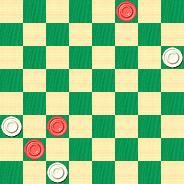
WHITE
White to Play and Win
"One does not master mathematics by studying trigonometry, solid geometry, or analytics at the start. The would-be mathematician must first ground himself in the basic study of addition, multiplication, subtraction, and division before he can cope with the abstract phases of advanced mathematics. Similarly, one cannot become an adept checker strategist without extensive training in the art of tactics. Look at the three-by-three ending in Example 14, by the well-known American problemist, Paul R. Semple, of Martins Ferry, Ohio. Can you take the white pieces, and without moving a piece, win in ten moves by executing a 'throwback two-for-one'? If you can't, don't divert your study to any other phase of the game until you can see through these snap traps in the twinkling of an eye!"![]()
Let's Send Yunior and John to Prague!
Have you ever visited Prague's historic Tyrs House, in the Czech Republic?

Tyrs House is the home of the Czech Sokol Organization, and is a famed sport and conference venue. Throughout its long history it has played a major role in the Czech athletics scene. And now, coming up at Tyrs House from October 14 through October 16, is the 2005 World Youth Qualification Tournament, as part of a major checkers event which includes other qualification and world championship tournaments. It seems that the enlightened people of Czechoslovakia rank mind sports right alongside physical sports!


Yunior Lopez and John Post
Yunior Lopez and John Post are to represent the International Checker Hall of Fame, the American Checker Federation, and the United States in the Go-As-You-Please (GAYP) section of the World Youth Qualification Tournament--- if they can raise enough funds to be able to make the trip. The winner of this event may well be declared world youth champion, as reigning champion Clayton Nash has crossed over the age-21 barrier.
The competition is expected to be tough indeed, as the world's best young players contend for first place. But Yunior and John are no easy marks, and are expected to show well. Yunior began playing checkers in 2000 and played his first live over-the-board tournament in 2004. In addition, Yunior ably captained the American Internet Team, which this past spring played an historic electronic match with Great Britain.
John has an even longer record in the game, having attended US Nationals several times as well as playing in Arkansas state tournaments, and currently serves as president of the Arkansas State Checker Assocation.
But now Yunior and John need to raise at least $1,100 each for airfare, not to mention food, lodging, and incidental expenses. It's a costly proposition for these deserving young checkerists, and they need our help.
There are several ways to assist. You can donate directly to Yunior and John; you can contribute through the American Checker Federation Online Store; or you can purchase a US-Great Britain Internet Match Booklet from Yunior. John Post can be reached at 105 Evergreen Estates, Russellville AR, 72802. Yunior Lopez can be found at 1200 Declaration Drive, Las Vegas, NV 89110, and he is offering a match booklet to anyone who donates $15 or more. If you would rather contribute through the ACF, go to their online donation site and page down to Dream Young or Travel Fund.
Yunior summed it all up in an exclusive Checker Maven interview: "My experiences with checkers have been great and this is why I still play checkers. When you attend a live tournament it is something like no other. You are in a room with great people where you can have great conversations, great games, and overall a great time. We are ready to play!"
The Checker Maven asks you to give the future of checkers a real boost, by helping Yunior and John represent America in Prague this October.![]()

September 19, 2005 followup: We have learned that John Post unfortunately won't be able to make the trip to Prague.
The Checker Maven is produced at editorial offices in Honolulu, Hawai`i, as a completely non-commercial public service from which no profit is obtained or sought. Original material is Copyright © 2004-2025 Avi Gobbler Publishing. Other material is public domain, as attributed, or licensed under Creative Commons. Information presented on this site is offered as-is, at no cost, and bears no express or implied warranty as to accuracy or usability. You agree that you use such information entirely at your own risk. No liabilities of any kind under any legal theory whatsoever are accepted. The Checker Maven is dedicated to the memory of Mr. Bob Newell, Sr.

